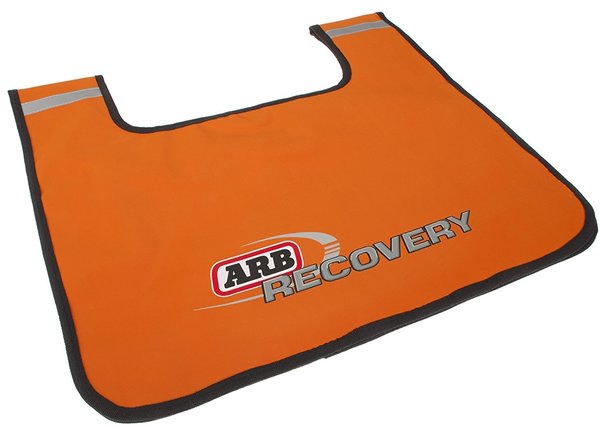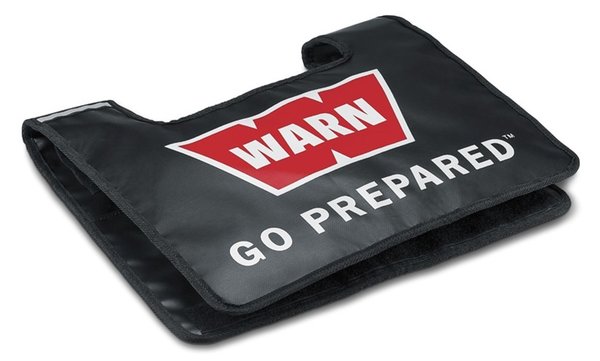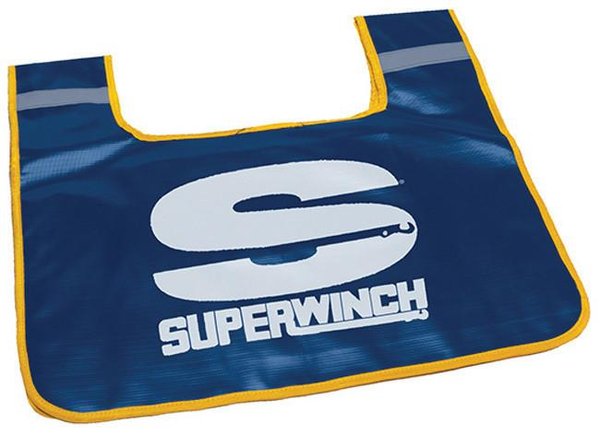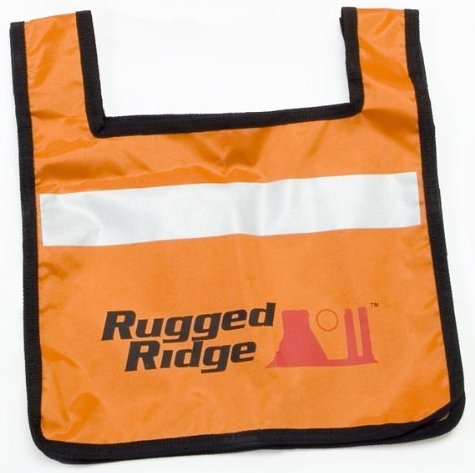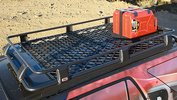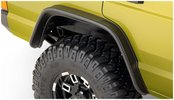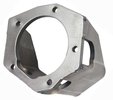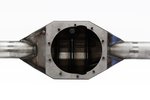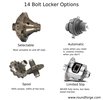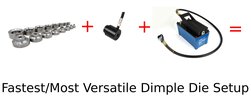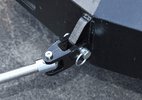Recovery Dampers for Winching and Snatching
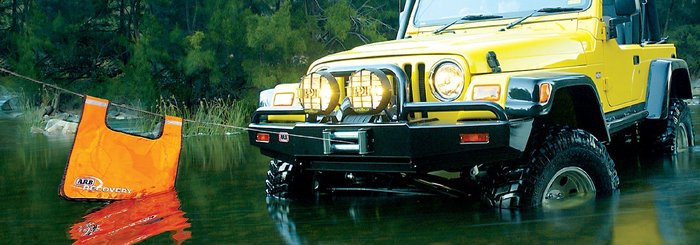
- All About Winch Cable
- 6 Reasons Tow Straps with Hooks Will Kill You
- Check out each other's recovery mount points. Through-welded shackles good. Trailer balls bad.
- Make a plan and sneakily weave in good technique. "Hey boss, let's start off with some easy pulls to start, then we'll get out and see if I need to dig a little."
What Does a Recovery Damper Do?
Recovery dampers are there to stop objects from flying through the air and injuring or killing people in a recovery operation. A recovery damper can contain some of the recoil from a broken recovery strap or winch cable in the event that either breaks in a 4x4 recovery operation.
The use of recovery dampers is now mandated in many 4x4 competitions due to the recognition of the danger that broken recovery straps and winch cables present.
There are three main accidents where you'll be glad you have a recovery damper. They are:
Your winch cable breaks
Sometimes a winch pull is a little too much for your winch line. Winch lines get weaker as you use them. They develop little burrs, splinters, and wear marks. Sometimes they get kinked (a really kinked cable should be replaced). And then one day you encounter a situation where the line fails. It could be anything: winching out of a deep mud hole, out of a vertical-wall rut with wedged tires, or just off a tricky high-centering rock.
Now, some of those situations can be avoided, but usually it requires some sweat. A deep rut might require you to get busy with a shovel and you might have avoided the high-centering with some rock-stacking (which you should unstack later...). Of course, most of us will skip the work and go for the winch. If we strain it too much, the cable breaks.
Often the cable will fall to the ground when it breaks, but cables that break under load can be unpredictable. We think that because winch cables do go the the ground so frequently that there are some individuals that say dampers aren't as effective as the 4x4ing population thinks, but no one ever says that recovery dampers are completely unnecessary.
Winch operations can also be dangerous when there are two or more vehicles involved and one of the drivers is inexperienced. Many inexperienced fourwheeleers don't realize that you can't jerk a winch line or use it as a recovery strap. You shouldn't tow with it or load it in any way that isn't slow and consistent, like the winch spooling in cable on the drum. Winch lines, including synthetic winch rope, are static, don't stretch, and have low maximum load ratings compared to true recovery straps.
A worn out 8000 lb winch line can easily snap if one of the vehicles in a recovery operation jerks the line.
You can even snap a new cable in what you think are ideal circumstances, because sometimes that's what happens.
Your recovery strap breaks
Recovery straps also break. First, they get worn out just like winch cables. We drag them through mud and dirt, over rocks, and through brush. Dirt works its way into the
fibers of the strap, takes up residence there, and slowly abrades the thin nylon away. You can stave this off for a while by cleaning
your strap and keeping it in a bag when not in use, but all straps will succumb in the end.
Next, recovery straps have a hard life. True nylon recovery straps stretch about 15-20% on a max pull, then return to their original length. They're often misused by newbie fourwheelers, or even by us veterans when we get frustrated, and we put way too much force on them. Wet recovery straps are weaker than dry ones. Also, repeated hard pulls on a recovery strap cause it to heat up and prevent it from returning to its resting length. This also weakens the strap. This is why you see so many recovery strap failures after repeated yanks.
You should be using your snatch strap with the least force possible. This means that you don't yank on the strap as hard as possible at the first chance you get. You gradually build up in force until you pull out the stuck 4x4. This gradual buildup is good for your body, your passengers, and the vehicles involved in the snatch operation because you aren't putting maximum force on everything all at once. Let the strap rest and cool down if you're working it a lot.
Of course, for some situations, like really deep, suction-y mudholes, you're going to be putting a ton of force on your strap. Uhhhh, actually it'll be many, many tons of force!
A recovery mount breaks
This seems to be a larger problem than people talk about. If you buy a commercially made bumper from a reputable manufacturer that's clearly marketed and designed for winch and recovery work, you're all good. Just make sure you do the installation correctly with good hardware.
But there are many people that use stock tow points, surface-mount shackle mounts on thin steel, crappily-welded shackle mounts, or just wrap a strap around a whatever "looks good". Cue the Youtube videos of people getting bumpers and frame horns ripped off.
When a recovery mount breaks, it is seriously lethal. When you're using a 28,000 lb. snatch strap and one end flies free with a broken shackle mount and a shackle, that's when people get killed. We're willing to bet that broken recovery mounts and improperly secured winch cables and straps have probably produced some of the most horrific injuries and deaths in fourwheeling during recovery.
If a recovery mount breaks, the kinetic energy in the mount point will be huge. While a damper might help, don't count on it saving your life if you need to pull using a questionable recovery mount.
One of the best things you can do to protect yourself is to make sure that the entire recovery mount point on any vehicle is absolutely solid, including winch hooks, D-ring shackles, D-ring shackle mounts, bumper hardware, and welds.
Protecting Yourself Against Other Wheelers' Unpredictability
There are things you have control over and things you don't. You can stop yourself from eating another donut. You can decide to go to the movies in sweatpants. You have the power to say, "No, you don't look fat, babe."
But you can't control other drivers and how they drive or treat their rigs. If you're in a recovery situation with someone you don't know, you don't know if they will skyrocket off with the snatch strap attached. You don't know if they'll drag your rig up a hill on the winch cable to "help you out". You don't always know if they've got good shackle mounts.
We don't think it's good to be suspicious of every driver you help or that helps you, but we do think it's a good idea to shield yourself from other people's unpredictability on the trail.
If you need to work with a stranger (stranger danger!) then do this:
Are Dampers a Bunch of BS?
We've heard this before since a cable can keep moving with a damper on it, but here's what we say: Don't expect
the damper to absorb all the recoil. It is a "damper" after all, not an
"eliminator". Maybe instead of breaking your window glass, the flying
strap just slaps it instead. Recovery can be
unpredictable and you still need bystanders to maintain a safe distance
from vehicles. We all accept some risk when we get out on the trail and recovery dampers are a way of reducing that risk. We've seen some interesting things from Ditch Hitch, but nothing that's easily available to the public.
Also, recovery dampers are mandated equipment for several 4x4 competitions and trail events, so if you want to participate, you'll need to pony up. For us, we'll keep using dampers until someone comes up with a recoil-less strap and cable.
How to Use A Recovery Damper
There are a few different opinions out there on the best way to use a damper, including placing it nearer to a particular mount point and using 2 dampers. The closer-to-a-mount-point folks think that you can capture a failed mount more easily. The two-damper folks think that 2 dampers dividing the cable into thirds will keep flying cable length shorter and provide more resistance to anything flying through the air.
However, we're going to go with manufacturer recommendations, which are: Velcro the recovery damper on your winch cable or recovery strap in the middle third section somewhere. If it has pockets for rocks or sand, fill'er up to get some weight in there.
We're also going to state the obvious (because these things need to be said for some of you - and yeah, us too) but don't suck your damper into a snatch block or roller fairlead. It can be a pain to unjam.
Lastly, you might notice that your winch damper almost has...a head hole? Yes, you are correct! Dampers can usually also be worn like a safety vest. In competitions, or even tough winch sections off road where a lot of winching is happening, the spotter can quickly put on and take off the damper as it's needed. This keeps his hands free for rock scrambling and winch work. Some winch dampers are brightly colored and have reflective patches. This helps alert the driver (and anyone else) to the spotter's location and is probably better than if the spotter wore a rock-camouflage suit. We can think of a few situations where it would just generally be handy to have a bright reflective object in any vehicle, so we prefer the brighter ones.
Recovery Damper Roundup
If you need a makeshift recovery damper you can use a blanket or a floor mat in a pinch. The dampers below are convenient because they'll always be with your winch gear, they're water-resistant, and (most importantly) they can attach to your winch cable securely without falling off or slipping down a sloped line.
ARB Orange Recovery Damper - HIGH VIZ ORANGE
This damper meets comp requirements and can be worn as a high-viz safety vest.
ARB's recovery damper is made from heavy duty orange vinyl. It's damper exceed's minimum requirements for competition weights. Due to its heavy weight it's designed to be used as is, but you could add more weight if you wanted. You can fill the single inside pocket with extra weight or also use it to carry recovery equipment like extra shackles when wearing the damper as a vest. Laying on your winch line it'll be 17" wide x 19.5" high. Since it's vinyl, it won't do well in very, very cold temperatures. In warmer weather you can roll it up, but in cold temps you should store it as flat as possible.
We like the bright orange color and reflective surfaces on this damper. Besides making it tough to lose, it also makes you highly visible when wearing it as a vest. It's easy to alert someone to something like a hard-to-spot turn on the trail. It's easy to hang off the back of your rig when you're broken down on the side of the road and want passing cars to see you and keep a little distance.
Warn Recovery Damper - WARN QUALITY
Meets competition weights and has a rubberized coating at the fold to prevent sliding.
This is another recovery dampener from Warn that complies with competition requirements. It's made of heavy duty black vinyl with a large red Warn logo. While it does have a reflective stripe, it won't have quite the visibility of one of the bright orange dampers. There are pockets on this damper that can be filled with sand to give it more weight. The section that folds over the winch line has a rubberized coating to prevent the damper from sliding down the winch line. This is very useful since a floor mat out of your 4x4 will easily slide off the line in certain situations, like pulling your rig uphill.
Throw it on like a vest and keep a couple shackles and snatch block in it for winch work in tricky trail sections.
Superwinch Winch Dampener - BUDGET DAMPER
Superwinch's recovery damper velcros to your winch line or recovery strap to keep you safe if a cable or strap breaks. The velcro on this vinyl damper securely keeps it in place on your line. It has a reflective stripe at the top and high-viz yellow piping around the outer edge. It's not as visible as a bright orange damper, but it's not terrible. Like other dampers it has a pocket that can be filled with extra weight or used to hold shackles or snatch blocks when being worn as a vest. It's a little cheaper than both the Warn and the ARB dampers.
Rugged Ridge Winch Line Dampener - CHEAP DAMPER
A slightly small, light recovery damper with bright colors and reflective stripe.
The Rugged Ridge damper is more of a light duty damper. It's pretty small and lightweight compared to other recovery dampers. It includes pockets which you'll need to use to add a little more weight. Rugged Ridge recommends adding at least 5 lbs of weight to it. It does use velcro to secure it to your winch line. It's made of a high-viz orange vinyl and has reflective stripes sewn onto it. While you can wear it as a safety vest, it really looks like it more suited as a kid-size. It's the least expensive damper here, but you have to compromise on the features if you want a cheap recovery damper.
Last updated: September 5, 2019
